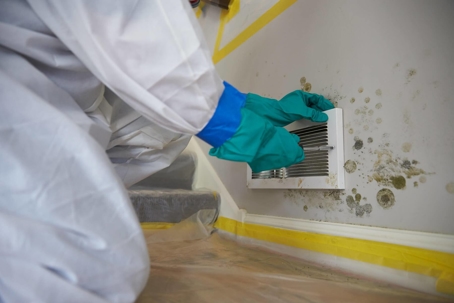There are thousands of different species of mold in the world, and it’s worth noting that not all of them are bad. Some are benign, others even have practical uses for things like medicine. However, when it comes to your home, one of the most common types of mold is also one of the worst to have. Black mold is extremely common, easily identifiable by its black color, and dangerous to you, your family, and your pets.
Because black mold can be such a huge problem, it’s important as a homeowner to know more about this threat and what you can do to about it. This blog is designed for you—we’ll help you better understand what black mold is, why it’s so dangerous, and what you can do to get rid of it as well as prevent it from coming back.
Black Mold Is Toxic
The first thing you need to know about black mold is that it’s toxic. Black mold spores secrete a toxic substance that can cause all kinds of negative health effects. Symptoms generally start out mild: stuffy nose, throat irritation, coughing, eye irritation, and other things which most people often interpret as seasonal allergies. However, with continued exposure could come chronic lung illnesses, lung infections, and so much more. Infants are prone to serious problems, including acute idiopathic pulmonary hemorrhage, according the CDC. People with compromised respiratory symptoms, such as those with asthma, are at an increased health risk as well.
While many people think this means simply don’t rub up against black mold or disturb it, the truth is that’s not enough. Black mold emits spores, which float through the air and come to rest on different surfaces. Those spores, when conditions are right, are what establish new colonies in different locations. However, they’re also invisible to the human eye, and we often breathe them without even thinking about it. When those spores enter your lungs, they could cause these serious health problems. When you have mold colonies in your home, the concentration of these spores increases exponentially, drastically increasing the impact to your health.
Black Mold Grows Easily
Black mold grows and spreads quickly. If conditions are right, a colony can form in your home in as little as two days’ time, and once it does, removing it is difficult. Not to mention, once a colony takes root, it tends to spread even faster, covering more area and emitting more dangerous spores the larger it grows.
Mold only requires three conditions in order to take root: a food source, a moisture source, and protection from harmful sunlight. Mold consumes carbon-based materials for food, which makes drywall, curtains, carpets, wallpaper, and even the inside of some air ducts a prime location for mold to settle, take root, and grow. Moisture can come from anywhere, but those areas which are consistently wet are the best places for mold to grow. This is why leaky pipes or flood damage are so prone to mold growth. Likewise, high indoor humidity can even cause mold to grow if it’s left alone for too long. Finally, mold prefers to grow in dark places protected from sunlight, which is why air ducts, dark corners, crawlspaces, or attics are so prone to mold growth.
The Signs of Black Mold Growth Are Easy to Spot
The convenient thing about black mold is it’s pretty unmistaken able when you spot it. Black mold often appears as dark, black-colored blotches which are pretty unmistakable. It’s also not uncommon to see these black splotches surrounded by a white, powdery-looking material. However, you don’t even need to spot mold with your eyes to know it’s present—it leaves a distinct, mildew-like smell which is unmistakable. If you’ve ever smelled any moldy or rotten food, you know this smell all too well.
When you think you see mold, do not touch it. Touching mold can disturb it and cause more spores to be released into the air. With you in the vicinity, that means you have a much higher chance of breathing that high concentration of spores into your lungs, where they can make you sick.
Mold Remediation Removes Black Mold Safely
Mold remediation is the process of cleaning colonies away, removing them and preventing them from growing. Mold remediation often involves focusing clean, dry air on the affected area to remove the moisture, and then using specialized cleaning materials to remove the colony from your home without tearing down or removing the initially-impacted materials. This is often done using specialized vacuum cleaners that are loaded with high-quality HEPA filters that remove spores and other mold cells from the air. This keeps your air clean while removing the colony completely.
If the mold has become too deeply-engrained in your home, you may have to remove it by tearing out the impacted material and replacing it. While this is certainly the more labor-intensive option, it may be the only way to truly get rid of your mold problem in some instances.
If your home has been impacted by black mold, call our Houston mold remediation team at Lone Star Pro Services at (832) 990-9499 right away!

